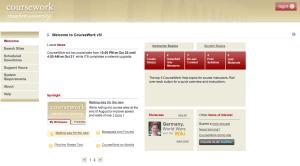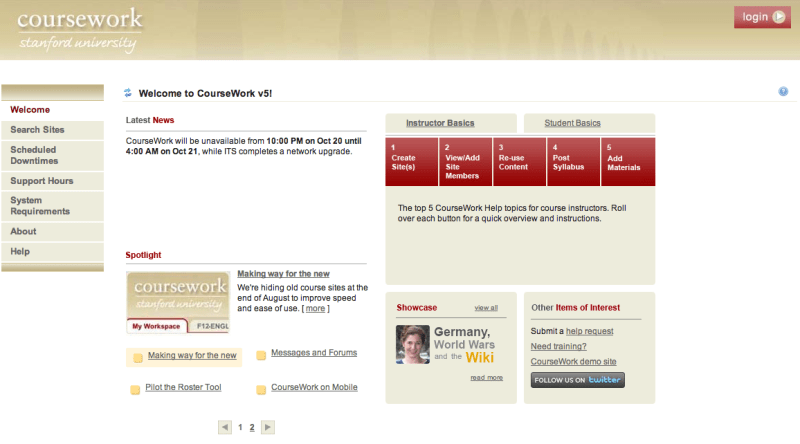This article is the first of two on Stanford’s course management software. The first part addresses criticisms of Stanford’s most popular system, CourseWork. The second will publish tomorrow and discuss alternative software currently in use.
CourseWork, Stanford’s centrally supported and oft-criticized class management system, has enjoyed a sustained growth in popularity among Stanford users even as faculty and University administrators continue to promote and develop attempts to complement or replace it.

“CourseWork usage has increased every year,” wrote Richard Holeton, director of academic computing services, in an email to The Daily. “We estimate that over 90 percent of Stanford students use CourseWork, and that it’s used by about three-quarters of courses.”
According to Holeton, the platform — originally the product of collaboration by a consortium including Stanford, MIT, UC-Berkeley and the University of Michigan — was used by 4,168 courses during the 2011-12 academic year, a 68 percent increase from 2005, which he attributed to generally positive reviews of the platform’s offerings by faculty.
“CourseWork would have the largest number of courses, because it’s centrally supported and it’s been out for a while,” said Registrar Tom Black, referencing the inability to date of other platforms to gain significant traction at Stanford. “Once faculty get used to something, they’re often reluctant to move.”
Nevertheless, a number of third-party challenges to CourseWork’s position have emerged in recent years, often in response to alleged shortcomings and with mixed reception among faculty.
Sam Purtill ’13, teaching assistant for PoliSci 51K: Election 2012, explained his course’s decision to use Piazza to provide a discussion forum as one reflective of the simplicity of the alternate platform and its ability to tally student input as an effective complement to CourseWork features.
“We weren’t trying to teach an entire course online,” Purtill emphasized.
By contrast, Russell Berman, director of the Thinking Matters program, described largely positive feedback with CourseWork among program faculty, with grading availability and the ability to disseminate class materials effectively most widely praised.
“It gets the job done,” Berman said. “Things are going to change, but they’re going to change differently across the humanities.”
Engineering and science-based majors have been quick, by contrast, to embrace new learning management solutions, with pronounced reliance on both internally developed solutions and programs intended for use in the new arena of online education to resolve issues found with CourseWork.
“Because we’re the Computer Science Department and we can build things, we tend to use home-grown solutions,” said Jennifer Widom, chair of the Computer Science Department. “Every faculty member can do what they want.”
Both Widom and Mehran Sahami ’93 M.S. ’93 Ph.D. ’99 emphasized the department’s — and the University’s — focus on developing online platforms, such as Coursera or Class2Go, capable of accessing a much broader audience. Such platforms have, however, encountered mixed reviews to date at Stanford when applied to smaller classes.
“Right now, there’s still work that needs to be done,” said Scott Klemmer, professor of computer science, who uses Coursera in teaching CS 147. “There’s a bunch of things you want to change for the in-person version…[but] there are some really frustrating bugs in all platforms. Everything we’re doing right now is an experiment.”
“It’s a really exciting area,” Black added. “Online courses are disturbing [content] delivery…For pedagogical reasons, it might just be a better way of helping students to keep up.”
Paul Kim, assistant dean of the School of Education, framed his school’s use of Blackboard — along with other appropriate platforms — as reflective of the school’s desire to accommodate outside lecturers and speakers who lack a SUNet ID.
Holeton acknowledged the existence of areas of concern with the current offering of CourseWork — such as sluggish speeds, outdated interfaces and complications with uploading and downloading multiple files — but insisted such issues would be resolved through both an upgrade of the CourseWork platform scheduled for next summer and the integration of third-party solutions like Piazza.
“We are early in these efforts, but we think they will be highly successful and popular,” Holeton said. “Successful integration…will enable us to increase the features we are offering while at the same time preserving the stability, scalability and core features that CourseWork already brings.”
“If instructors want to use [a platform], we want to make sure that we integrate it well,” Black said, adding that he anticipated an increased emphasis being put on the role of online dialog between faculty and students. “We’re looking for more capability to interact with each other.”
